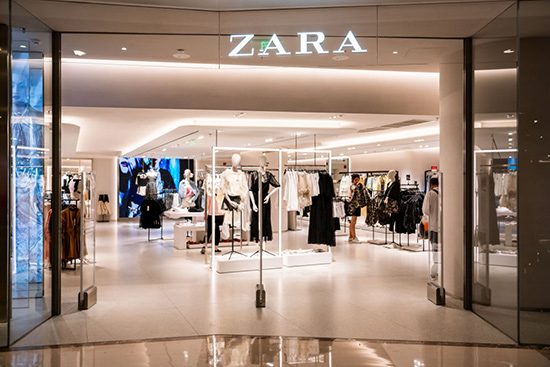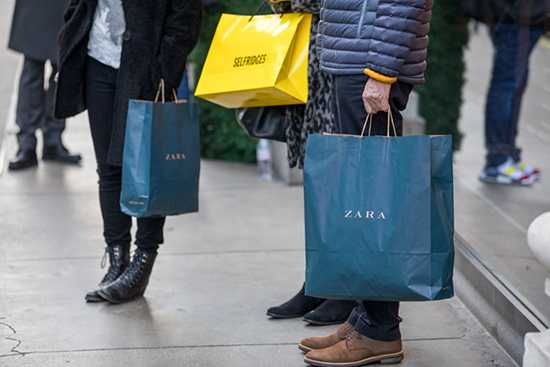H&M和Zara以退為進,關店促進增長
兩家公司去年做出了精簡實體店網絡以及加大線上銷售投入的決定,如今雙方都看到了這一決定所帶來的效益。
|
面對電商的威脅,歐洲快時尚巨頭的動作一直以來十分緩慢,但在這場競爭中,它們更像是已經與對手拉開了足夠的距離,不僅生存沒有問題,甚至可能會走向繁榮。 瑞典H&M、Monki和Weekday品牌的母公司Hennes & Mauritz,以及西班牙Inditex(Zara和Massimo Dutti品牌的母公司)去年做出了精簡實體店網絡以及加大線上銷售投入的決定,如今雙方都看到了這一決定所帶來的效益。 18個月前,H&M還在痛苦地對其在線店面進行再一次改造,而且似乎在拼命地開設更多盈利無望的店面。快進至股市異常動蕩的今年夏天,H&M在最近6月底的季度財報中宣布,公司成功地保住了15%的業績增長。這一業績值得稱道,原因有兩個:第一,其夏季系列服飾非常暢銷,銷售額同比增長了12%;第二,公司稱預計將連續第四個月削減其未售庫存,并預測庫存水平在本財年年底將繼續下降。公司股價如今已經從去年8月創下的14年以來的最低水平,上漲了三分之一。 |
Europe’s fast fashion giants may have been slow to wake up to the threat posed by e-commerce, but it looks more and more like they have raised their game enough to survive—and maybe even prosper. Hennes & Mauritz, the Swedish company behind H&M, Monki and Weekday, and Spain-based Inditex (owner of Zara and Massimo Dutti) are both seeing the benefits of decisions taken last year to trim their networks of physical stores and throw more resources into online sales. Eighteen months ago, H&M was still struggling with another makeover of its online store and seemingly hell bent on opening more stores that would never pay for themselves. Fast forward to this summer—a tumultuous one for stocks—and H&M has managed to hold on to the 15% gain it made when it announced its most recent quarterly earnings in late June. The results were notable for two reasons: one, its summer collections arrived with a bang, with sales rising 12% from a year earlier; second, it said it expected to whittle away its unsold inventory for the fourth quarter in a row, and forecast it would continue falling through the fiscal year-end. Shares are now up by one-third from the 14-year low they hit last August. |

|
H&M能夠脫困的一個重要因素在于其對自身店面印跡的挑剔目光。在去年關閉140家店面之后,H&M調低了其今年的開店計劃,從全球175家凈店面數降至130家,其店面組合持續“優化”的指引也暗示著公司將進一步縮減店面數量。(一名公司女發言人拒絕透露公司是否會因為當前全球經濟放緩而對該數字做進一步的調整。)首席執行官卡爾-約翰·佩爾森對投資者表示,一些店面的開設可能會延遲,因為公司正在等待更加合理的租金費率。然而迫在眉睫的問題在于,公司正在削減歐洲的過剩產能,同時也將在今年削減歐洲大陸的H&M店面數量的凈值。 與此同時,Zara的母公司Inditex發現,在前首席執行官帕布洛·伊斯拉的領導下,自家全球店面數量翻了兩番,達到了近7500家。盡管這一舉措在一定程度上反映了難能可貴的集團資產組合多元化策略,也就是將高端品牌Massimo Dutti和青年品牌Bershka納入麾下,但擴張也給Inditex留下了眾多在電商時代入不敷出的實體店面。作為對策,伊斯拉去年在全球關閉了355家店面,較其最初的計劃關店數量高出了76%。今年,在新任首席執行官卡洛斯·克雷斯珀的帶領下,公司還將關閉250家店面,并新開300家店面。Inditex對于置評請求未予回復。 |
A big factor in H&M's turnaround is the critical eye it's cast at its store footprint. After closing about 140 stores last year, H&M has revised down its plans for store openings this year from a net 175 worldwide to 130, and guidance for continued “optimization” of its store portfolio hints at further pruning. (A company spokeswoman declined to say whether the targets would see more revisions given the ongoing global slowdown.) Chief Executive Karl-Johan Persson told investors that some openings may be delayed while the company waits for more acceptable rent levels. More immediately, it’s cutting overcapacity in Europe, with a net reduction in H&M brand stores across the continent this year. Zara parent Inditex, meanwhile, saw its global store count triple to nearly 7,500 under former CEO Pablo Isla. While some of that reflected a valuable diversification of the group’s portfolio to include upscale Massimo Dutti and youth-focus Bershka, the expansion left it with many stores that couldn’t pay their way in the age of e-commerce. Isla reacted by closing 355 stores last year, 76% more than he had originally planned. This year under new CEO Carlos Crespo, the company is set to close another 250, while opening 300. Inditex didn't respond to a request for comment. |

|
然而,盡管H&M和Inditex都在關閉店面,但它們在實體店領域依然處于增長狀態,兩家公司今年的凈店面數預計都將有所增加。Coresight Research稱,美國零售商今年已經宣布的閉店數量超過了2018年全年的總和。從年初至今,包括Gap和A&F本土標志性品牌在內的零售界已經宣布砍掉了約4500個凈店面數(如果不計算新開店數量,關閉總數則超過了7500家)。2018年全年,美國凈閉店數量略超過2600家。鑒于這一背景,H&M和Inditex的表現著實驚艷。 這兩家公司在線上銷售的計劃甚至更加令人震驚。(采用大膽的舉措可能是應該的,因為這兩家公司稱,其在線銷售額還不到銷售總額的15%。相比之下,美國服飾銷售額的約27%都來自于線上銷售。)Inditex今年已經在沙特、阿聯酋、黎巴嫩、埃及、摩洛哥、以色列、塞爾維亞和印尼開設了網店(服務對象涵蓋近5億人口),而且公司計劃為其秋冬系列在南非、卡塔爾、科威特、巴林、阿曼、約旦、哥倫比亞、菲律賓和烏克蘭開設網店(新增2.75億人口)。 伊斯拉在5月說:“不管客戶身在何處,即便是那些公司當前沒有設立實體店的地域,我們也希望每位客戶都能買到我們的時裝產品。” |
But despite store shutterings, both H&M and Inditex are still in growth mode in the realm of brick-and-mortar with net store count expected to increase this year at both chains. That is remarkable in a year when, according to Coresight Research, U.S. retailers have already announced more store closures than they did in the whole of 2018. The industry, including homegrown icons such as Gap and Abercrombie & Fitch, has announced some 4,500 net store closures so far in 2019 (and over 7,500, unadjusted for new openings). For the whole of 2018, net closures just topped 2,600. The two companies’ plans for online sales this year are even more striking. (A bold approach is perhaps merited, given that both firms report online sales that are still less than 15% of overall sales. For comparison, around 27% of U.S. apparel sales take place online.) Inditex has already opened online stores this year in Saudi Arabia, the United Arab Emirates, Lebanon, Egypt, Morocco, Israel, Serbia, and Indonesia (serving a combined population of nearly 500 million), and it plans to have stores up and running for its fall/winter collections in South Africa, Qatar, Kuwait, Bahrein, Oman, Jordan, Colombia, Philippines and Ukraine (another 275 million). "We want to make our fashion collections available to all our customers, wherever they are in the world," Isla said in May, "even in those markets which do not currently have our bricks-and-mortar stores.” |

|
與此同時,H&M已許諾對其線上店面進行大的升級,包括改善H&M導航以及產品展示,縮短送貨時間(與其他專業的在線零售競爭對手相比,例如Zalando和 Boohoo,當然還有亞馬遜,送貨的確是H&M的短板)。公司還承諾利用公司去年投資的金融科技獨角獸Klarna,提升支付的靈活度。 不可否認的是,只要是企業重組都會帶來損失。H&M的利潤可能會因為較高的投資成本而出現下滑,而且它不得不提升借貸額來發放去年的股利。在今年年初調高派息額度之后,Inditex如今給股東的派息總額占到了年度利潤的約80%。但這一點與摩根士丹利分析師吉歐夫·魯德爾的看法相左,他認為Inditex采用了一些雖然合法但十分隱晦的會計方法,來粉飾其過去四年中的利潤水平。 即便如此,由于有著850億歐元的市值,阿曼西奧·奧爾特加(全球最富有的零售商)的Inditex帝國即便犯幾個小錯,可能也不會傷筋動骨,而且佩爾森的H&M似乎已經度過了最困難的時光。這也是眾多其他零售商樂于見到的事情。(財富中文網) 譯者:馮豐 審校:夏林 |
H&M, meanwhile, is promising big upgrades to its online store, including H&M’s improved navigation and product presentation and shorter delivery times (the latter in particular being an area where it has compared unfavorably to online-only rivals such as Zalando, Boohoo, and, of course, Amazon.com). It also promises more flexibility in payment, building on its investment in fintech unicorn Klarna last year. All of the corporate rewiring is, admittedly, taking its toll. H&M is likely to report falling profits this year due to high investment costs, and it had to raise its borrowing to fund last year’s dividend payment. After a dividend increase earlier this year, Inditex is now paying out some 80% of its annual profit to shareholders, which sits uncomfortably with arguments from Morgan Stanley analyst Geoff Ruddell that the company has used some obscure—albeit legitimate—accounting methods to give a flattering account of its profitability over the last four years. Even so, with a market value of 85 billion euros, the Inditex empire of Amancio Ortega, the richest retailer on Earth, can probably survive a mistake or two. Persson's H&M also seems to have the worst behind it. Plenty of other retailers would be glad to boast as much. |













